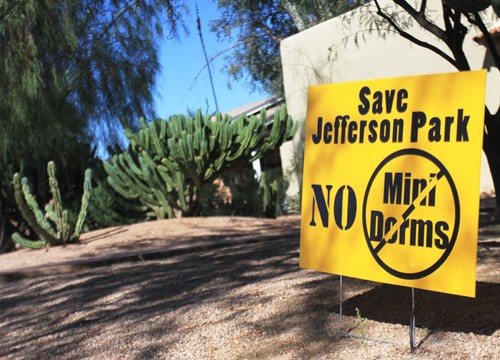Residents near campus are trying to preserve their neighborhoods — by making them less appealing to students.
A Neighborhood Preservation Zone design manual aims to limit construction of “”mini-dorms”” in Jefferson Park, a neighborhood about a mile north of campus. Residents are working to pass a design manual restricting construction and renovation in areas like house size and height, architectural style and placement of windows and balconies. Members of the manual’s advisory board and representatives from the City of Tucson will meet to discuss the latest draft on Wednesday.
The battle between residents and developers has gone on for almost 10 years, according to Bob Schlanger, a Jefferson Park resident and a member of the manual’s advisory board.
“”They’re big lots, so (developers) would build a second house in the backyard, and what you would end up with is up to nine bedrooms on a property,”” Schlanger said. “”That’s no longer single-family zoning, that’s high density.””
Schlanger said these “”mini-dorms”” destroy the character of the neighborhood.
“”There’s not a whole lot of nice old neighborhoods in this town, and they’re typically around the University area,”” said Schlanger, who noted about 20 other neighborhoods are eligible for preservation zoning. “”There are many, many long-term residents who don’t want to see them turned into student slums.””
Many students are drawn to the newly remodeled houses.
Communication junior Griffin Bell lives in a recently completed, six-bedroom house in Jefferson Park.
“”That was a reason we chose it,”” said Bell, who had not heard of the design manual. “”It was a brand-new, big house with enough bedrooms. It was very practical.””
Local developer John Lee said the manual will make it difficult to improve his properties in the area.
“”They’re doing a disservice to the neighborhood because they’re preserving things that ought not be preserved,”” said Lee, who rents to students.
Students are largely unaware of the design manual, according to communication senior Lily Minnig. Minnig, who lives in a nearby neighborhood, is the only student to serve on the manual’s advisory board.
“”We are trying to make changes to the guidelines that we think would fit the neighborhood,”” Minnig said. “”But what they’re really trying to do is make it so houses are small so students don’t want to live in them.””
Minnig said she feels like she has to “”stand up”” for students at meetings because they are often associated with crime and parties.
Schlanger said large groups of students living in one house can present problems for other residents.
“”A family can’t live next door to such a thing,”” Schlanger said. “”Most (mini-dorms) are two-story; it invades your privacy. Even the nicest of students are still difficult as neighbors because, among other things, they tend to be nocturnal, and normal adults work during the day, have jobs and go to bed at night.””
Schlanger said the incompatible lifestyles of students and families are not related to the design manual.
“”The behavioral issues are a separate thing from the whole NPZ (Neighborhood Preservation Zone) and we will never cease to work on them in any way we can,”” Schlanger said. “”There are many avenues we have open, but right now we have to finish this process.””
Students will always live in Jefferson Park because of its proximity to campus, Minnig said.
“”I would like to see there not be a manual at all,”” she said. “”I personally believe that if you chose to invest in a neighborhood within one mile of a university, then those are things that you should have thought about.””








